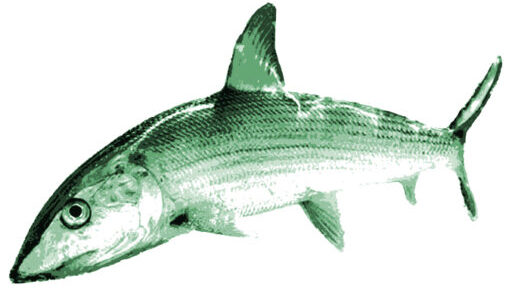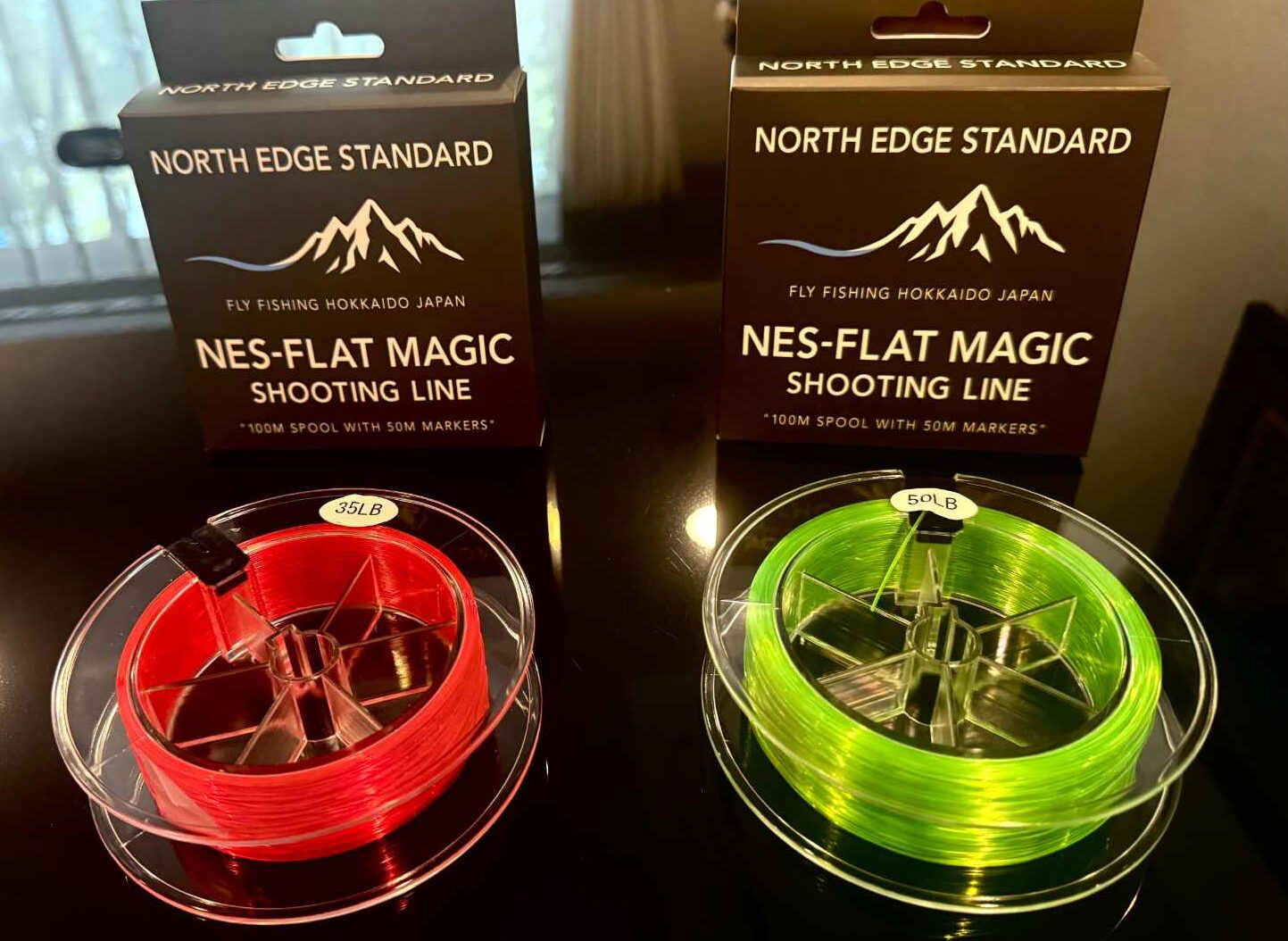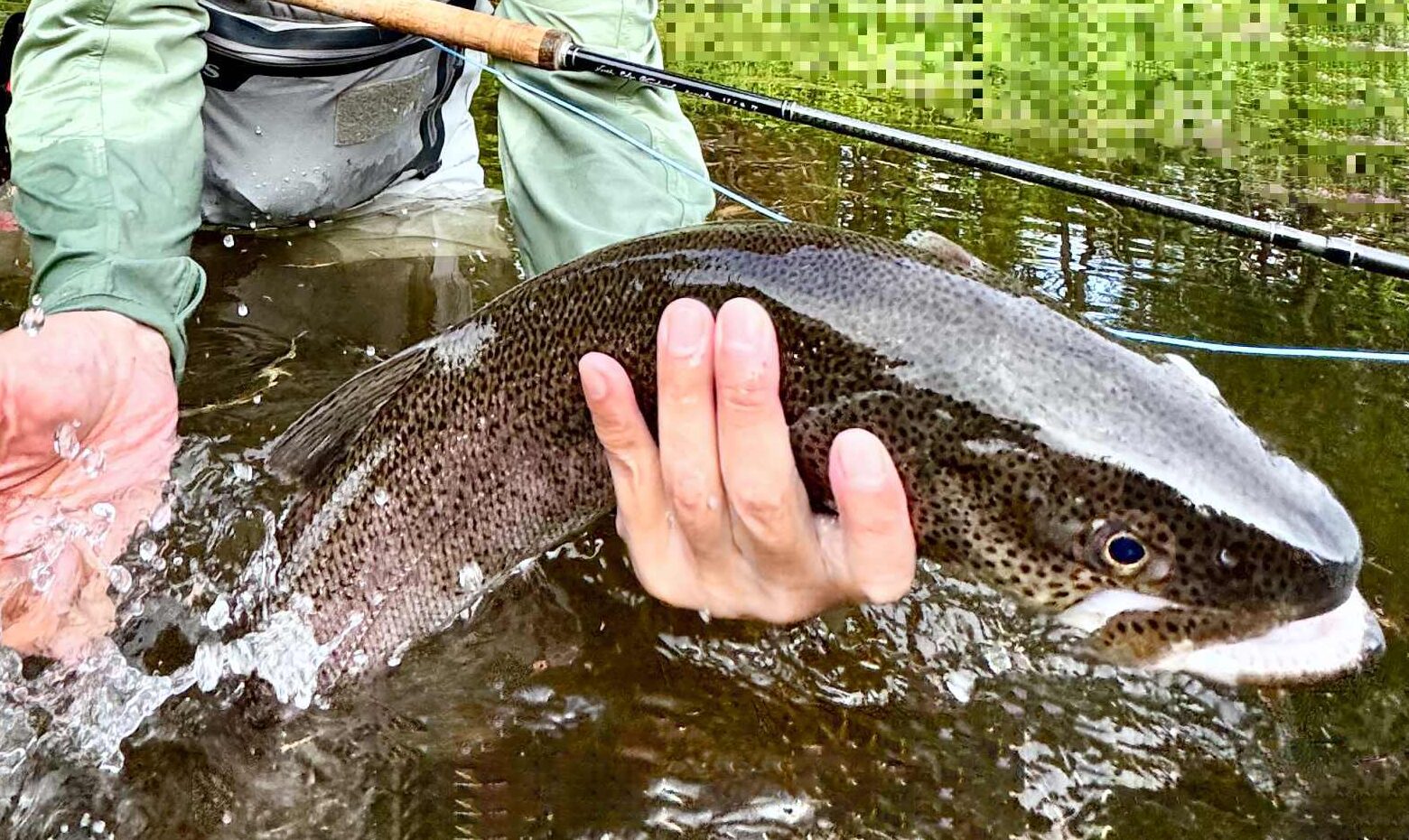
(08-18-2025 →Click here for English)
6月に北海道発のブティックブランド、「North Edge Standard」から、ナイロンモノフィラメントのシューティングライン「Flat Magic Shooting Line」が発売された。
North Edge Standard (以下NES)は、今後、かなり尖った商品を随時投入する算段でいるようだ。このシューティングラインを皮切りに、今年末頃までにはフライロッドのラインが登場する予定で、その中のいくつかは、東レのT1100カーボン素材をバットからティップまで通しで使いこれにコンポジットカーボンクロスを被せることで、これらはロッドデザインの概念を再定義するレベルになるかもしれない。「メータークラスのトロフィーフィッシュが獲れるロッド」でありながら、「最高のフライキャスティング性能を引き出す素材とテーパー」 が私の見立て。今後が楽しみだ。
このNESのFlat Magic Shooting Lineラインも、私自身、年初から殆ど毎週使って来て、他を圧倒する性能であると思ったので紹介することにした。私が特出していると感じた性能は以下。
- 北海道の冬の低気温にも対応する、圧倒的な「メモリーフリー(絡み軽減)」性能。
- 特殊シリコンコーティングによる、ロッドガイド内のラインの走りの良さ、遠投性能。
- リトリーブしたラインが水に沈みにくい低沈降性能。
- ラインのグリッピング、ハンドリング性能が高い。

(上記の写真は、朝一リールからシューティングラインを出して10分後の状態。既にライン癖は全くない。)
中でも、「メモリーフリー(絡み軽減)」性能は特筆すべき点がある。通常のナイロンモノフィラメントのシューティングラインだと、朝イチの釣り場でラインの巻きぐせを取ることから始まるわけだけど、このラインだとこのプロセスをスキップしても使い始めてすぐに巻き癖は取れてしまう。断面がフラットのラインは、グリッピングとハンドリング性能に優れるものの、遠投性能は真円タイプに劣ると思っている人もいると思うが、このラインに関してはそのマイナスはない。
これを製品化するために、NESのようなブティックブランドのメーカーが、彼ら専用の素材に資金投資したのは、勇気ある決断だったと思う。その甲斐あって、出てきたモノは確かに今時点では、海外ブランド含めて他に類を見ない圧倒的な性能だと思う。
そこで、折角の良いモノなので、ナイロンモノフィラメントのシューティングラインを最高のコンディションを維持したまま使い倒すための、「シューティングラインの取り説」を作ってみたので、以下、ご興味があれば参考にしてみてください。
- ラインのヨレ解消。
断面がフラット形状のシューティングヘッド用のシューティングラインのナイロンモノフィラメントは、38年程前に澤田賢一郎さんがハンドリングの良さを追求して、断面がフラット形状のものを初めて世に出したのが最初だ。今や世界のシューティングラインはフラット形状が主流になりつつあるが、NESもこのフラット形状を採用している。スペイキャスティングは、常にコンティニュアステンションの円運動で投げ続けるため、時間の問題でシューティングラインにヨレは必ず入る。この時に、断面がフラット形状のラインだと、ヨレが入った時点でそれが際立って気になると言う方も多いと思う。これは、フラット形状特有の問題ではなく、真円のナイロンモノフィラメントでも起こることなのだけれども、このヨレを簡単に解消する方法がある。以下の動画を参考にして見てください。足元にリトリーブしたシューティングラインにヨレが出てきたら、ロッドをヨレを解消する方向に数十回回転してやれば、快適な状態に直ぐに戻すことができる。これは、スペイキャスターにとって必須の基本中の基本ワザだ。以下の動画をご確認ください。
- ラインのキンクの解除。
一日釣りをすると、キャスティングに自信がある人でも1日に何度かは、ナイロンモノフィラメントのシューティングラインが絡むことはあると思う。“Flat Magic Shooting Line”だと、この絡みのトラブルは軽減される。それでも、やっぱり絡む時はある。その時の一番の問題は、ナイロンモノフィラメントにキンクが発生する場合があると言うことだ。キンクは一回発生するとずっと残り続ける厄介なものだ。これを放置するとラインの強度は落ち、そのキンクの付いた部分の周辺にまた別の絡みを誘発することになる。キンクは手で引っ張っても、ラインを高温のお湯につけても取れない。この時に、有用なのが、ヒートガンだ。これをナイロンモノフィラメントが焦げないように引っ張りながら、ラインをクルクル回しながら熱を表面に均等に加えて行くと、短時間で完璧にキンクは解消されて元に戻る。最初の慣れないうちは、ラインのど真ん中を焼いてラインを台無しにしないために、ラインの切れっぱなしで練習しておくことをお勧めするが、熱の加え方のサジ加減はそれほど難しくない。ちなみにヒートガンは、フライラインの先端にループを作るためのウェルダー加工する時に必須の道具。また、ノットレス・ナイロンテーパーリーダーのバット部に近い場所にキングが出た時、特に高価なソルトウォーター用のテーパーリーダーはその状態のまま使うと、繊細なボーンフィッシュやクロダイの釣りでは致命的に魚に警戒心を与えるのでキンクは絶対避けたい。ヒートガンを使えば高価なソルトウォーター用のテーパーリーダーも無駄にせずに使い続けることができる。と言うことで、使い道が色々あるので持っておいて損はない道具だ(尚、ウェルダー加工によるフライラインの加工方法は、岡田裕師さんが、素晴らしい説明を YouTubeでされているので、是非、参考にされると良いと思います。)



左はキンクの目立つライン。真ん中は回しながらヒートガンの熱を加えているところ。右は完璧にキンクが取れた状態。
- 低沈高性能の維持。
どのナイロンモノフィラメントでも吸水はするのだけど、NESのFlat Magic Shooting Lineは、特殊シリコンコーティングが施されている分、低沈高性能が高い。とは言え、数時間使い続けると吸水は進み1日の後半には沈降性能は落ちる。ここでお勧めは、1日に1度は、使っているスペイ用のフライライン含めて、シューティングラインにもシリコンミューシリンのペーストか、PEライン用のシリコンスプレーを塗布してやるとよい。因みにシリコンミューシリンをスペイラインに塗布する人はあまりいないと思うが、私はスイング性能を維持させるために随時塗布している。 宿に戻った時に、ラインの水気をティッシュで取ってシンクティップを除くフローティングライン部分と同時にシューティングラインにも一緒に塗布するとベストだ。こうするとフライラインのスイング性能もシューティングラインの低沈降性能も長持ちする。何もしないで翌日を迎えると、リールスプールの中でたっぷり水分を吸ったシューティングラインと一日付き合うことになる。



- 「ループ to ループ」の接続のヒント。
最後にもう一個気を使いたい点、それは、ナイロンモノフィラメントとフライライン、ナイロンモノフィラメントとバッキングラインのそれぞれの接続部分の「ループ to ループ」の接続部について。もし、あなたがトロフィーサイズの魚をターゲットにする方でしたら特にお勧めするのが、ナイロンモノフィラメント側に作るループは、ダブルサージェントノット。それも、ラインの先端を2重に折り曲げて2重のループにしてやると良い。これをやると大物が掛かった時に、ナイロンモノフィラメントラインがフライラインのループに食い込むのを軽減することができ、フライライン側のループも長持ちする。また、同じことがナイロンモノフィラメントとバッキングとの接続にも言える。昨今、バッキングは、PEラインを使う人が多いと思うが、PEライン側にビミニツイストでループを作り、これを2重にしたナイロンモノフィラメントを接続させると最強の強さが得られる。上級者のテクニックになりますが、トロフィーフィッシュハンターにはお勧めです。
NES “Flat Magic Shooting Line” / User Guide for Shooting Lines
In June, a boutique brand from Hokkaido, North Edge Standard, released a nylon monofilament shooting line called the “Flat Magic Shooting Line”.
North Edge Standard (hereafter NES) seems to be gearing up to roll out a series of highly cutting-edge products. Starting with this shooting line, they plan to release fly rod lines by the end of this year. Some of these rods will use Toray’s T1100 carbon material continuously from butt to tip, wrapped with composite carbon cloth— In my view,an approach that redefines the very concept of rod design. These will be rods capable of landing 40in trophy fish, while also delivering the highest level of fly-casting performance through their materials and tapers. I’m genuinely excited to see what’s coming next.
As for the NES Flat Magic Shooting Line itself, I’ve personally been using it almost every week this season, and I felt it delivered performance that overwhelms the competition, so I decided to introduce it here. Here are the features that I found particularly outstanding.
- Exceptional memory-free design minimizes tangles, even in freezing temperatures in Hokkaido.
- Advanced silicone coating enhances the line speed running through the rod guides, resulting in extra casting distance.
- Low-sink technology provides excellent water-cutting performance for seamless shooting.
- Flat monofilament enhances gripping and handling control.

(The above photo shows the state of the line 10 minutes after pulling the shooting line off the reel first thing in the morning. At this point, there is no line memory at all.)
Among these, the memory-free performance deserves special mention. With most nylon monofilament shooting lines, you typically have to start the day by removing line coils. With this line, however, the coils disappear quickly even if you skip this process. Some people believe flat nylon monofilament lines excel in grip and handling but fall short in distance compared to round lines, but with this line, that drawback is completely absent.
For NES, a boutique manufacturer, to invest in developing their own exclusive material to bring this product to market was a bold decision. Thanks to that, the result is a line with truly unmatched performance—even compared to major overseas brands.
Since this is such a great product, I have also created a “User Guide for Nylon Monofilament Shooting Lines” so that you can get the best out of them while maintaining top condition. Please use it as a reference.
- Eliminating Line Twist
The world’s first Flat Mono Shooting line was introduced about 38 years ago by Ken Sawada, who prioritized handling performance. Today, flat-mono shooting lines are becoming the global standard, and NES has adopted the same shape. Because Spey casting involves circular motion with constant tension, twists in the shooting line are inevitable over time. With Flat Mono Shooting lines, these twists can feel especially noticeable. This isn’t unique to flat monofilament—it also happens with round nylon monofilament—but there’s a simple fix. When you see twists in your retrieved line at your feet, just rotate the rod repeatedly in the direction that cancels the twist. Within seconds, the line will return to a smooth condition. For Spey casters, this is a basic and essential skill. Please check the movie below.
- Removing Line Kinks
Even skilled casters will occasionally experience tangles in their nylon monofilament shooting lines during a day of fishing. While the “Flat Magic Shooting Line” dramatically reduces tangling, it can still happen. The real problem comes when a kink forms. Once formed, a kink will remain, weakening the line and making future tangles more likely.
Neither pulling the line by hand nor soaking it in hot water will remove a kink. The best solution is a heat gun. By gently rotating the line while applying heat evenly to the surface, you can completely eliminate kinks in a short time without burning the monofilament. I recommend practicing on scrap line before trying this on your main line, but the technique isn’t difficult to master. A heat gun is also essential for making welding loops in fly lines, and it works for fixing kinks in expensive saltwater nylon leaders as well. Using kinked leaders with wary fish like bonefish or black sea bream is a fatal mistake, but with a heat gun, you can restore them and keep fishing confidently. It’s a tool well worth owning.
(For an excellent explanation of fly line welding, see Hiroshi Okada’s video on YouTube link.)



Left: A noticeable kink line. Center: Applying heat with a heat gun while rotating.Right: The kink has been completely removed.
- Maintaining Low-Sink High Performance
All nylon monofilament absorbs water, but since the Flat Magic Shooting Line is treated with a special silicone coating, it offers superior low-sink performance. That said, after several hours of use, water absorption progresses and its buoyancy performance does decline toward the latter half of the day. To counter this, I recommend applying silicone mucilin paste, or a silicone spray for Spun Gel lines, to the shooting line once a day—together with your Spey fly line.
Incidentally, not many people apply mucilin to their Spey lines, but I do it regularly to maintain swing performance. The best practice is, once back at your lodge, to wipe off moisture with tissue and apply the coating to both the floating section of your line (excluding sink tips) and the shooting line at the same time. If you do nothing and leave it until the next day, you’ll be spending the entire day with a shooting line in the reel spool, swollen with absorbed water.

- Loop-to-Loop Connection Tips
Finally, pay attention to the loop-to-loop connections—between the monofilament and the fly line, and between the monofilament and the backing. If you’re targeting trophy-sized fish, I strongly recommend tying the monofilament loop with a double surgeon’s knot, doubling the line to create a two-strand loop. This reduces cutting into the fly line’s welded loop when fighting large fish, extending the life of the loop in your fly line.
The same applies to the backing connection. Many anglers now use Spun Gel backing; if you tie a Bimini twist on the Spun Gel line side and connect it to a doubled monofilament loop, you get maximum strength. This is an advanced technique but highly recommended for serious trophy hunters.



